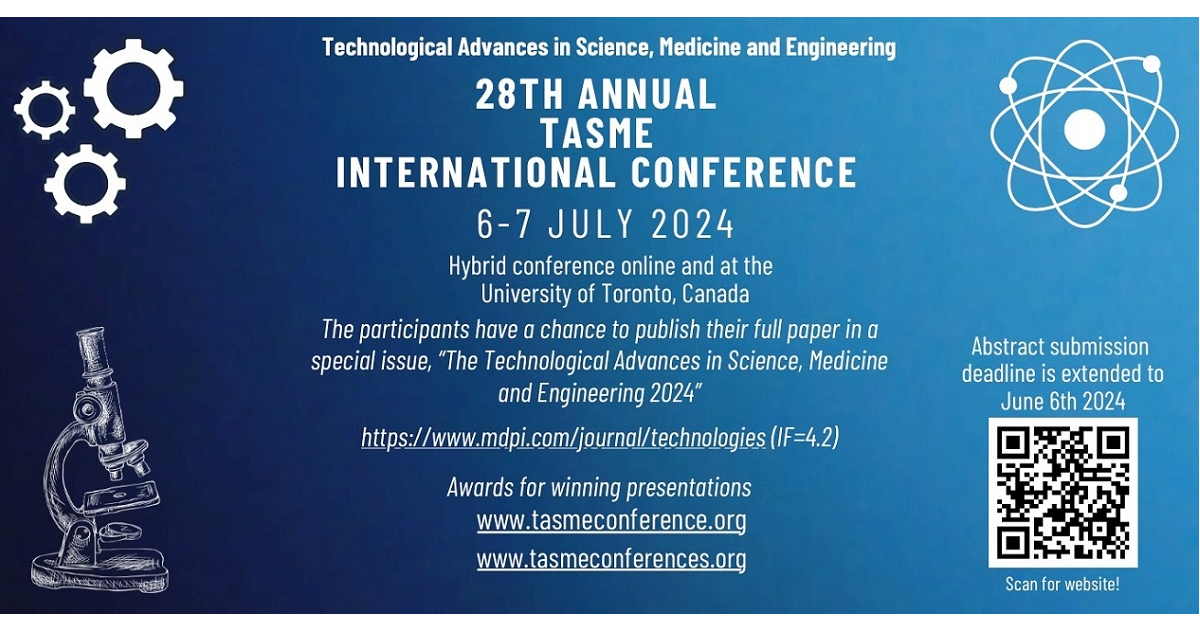Technological Advances in Science, Medicine, and Engineering 2024
A special issue of Technologies (ISSN 2227-7080).
Deadline for manuscript submissions: closed (20 June 2025) | Viewed by 58645

Special Issue Editors
Interests: wireless communications; signal processing; optical–wireless communications; machine learning; IoT; tracking and localization; integrated sensing and localization; VANETs; aerial–terrestrial networks
Special Issues, Collections and Topics in MDPI journals
Interests: AI in medicine; infectious and inflammatory diseases; neutrophil extracellular traps (NETs); molecualr mechanisms; drug scrreening
Special Issues, Collections and Topics in MDPI journals
Special Issue Information
Dear Colleagues,
This Special Issue showcases papers emerging from the 28th Technological Advances in Science, Medicine, and Engineering (TASME) In-Person/Zoom Hybrid Conference (https://tasmeconference.org/; July 6–7, 2024; the University of Toronto’s Scarborough campus), focusing on technological advances in science, medicine, and engineering. The subject areas include, but are not limited to, the following:
- Civil and environmental engineering;
- Electrical and mechanical engineering;
- Materials and energy technology;
- Cancer and nervous systems;
- Immunity, lunch infection, and COVID;
- Internal medicine, mental health, public health, and healthcare system;
- Life and environmental sciences;
- Physical sciences, tech innovation, and IoT applications;
- Medical technology, biotech and pharma, and drug design;
- Information technology (cybersecurity, data science, and E-learning)
In addition, we also collect original research and review papers which are not from the conference on the above-mentioned topics.
Prof. Dr. Xavier Fernando
Dr. Nades Palaniyar
Guest Editors
Manuscript Submission Information
Manuscripts should be submitted online at www.mdpi.com by registering and logging in to this website. Once you are registered, click here to go to the submission form. Manuscripts can be submitted until the deadline. All submissions that pass pre-check are peer-reviewed. Accepted papers will be published continuously in the journal (as soon as accepted) and will be listed together on the special issue website. Research articles, review articles as well as short communications are invited. For planned papers, a title and short abstract (about 250 words) can be sent to the Editorial Office for assessment.
Submitted manuscripts should not have been published previously, nor be under consideration for publication elsewhere (except conference proceedings papers). All manuscripts are thoroughly refereed through a single-blind peer-review process. A guide for authors and other relevant information for submission of manuscripts is available on the Instructions for Authors page. Technologies is an international peer-reviewed open access monthly journal published by MDPI.
Please visit the Instructions for Authors page before submitting a manuscript. The Article Processing Charge (APC) for publication in this open access journal is 1600 CHF (Swiss Francs). Submitted papers should be well formatted and use good English. Authors may use MDPI's English editing service prior to publication or during author revisions.
Keywords
- information systems
- artifical intelligence
- medical science
- immunology
- material science
- intelligent communications
- engineering
- biosystems engineering
- urban forestry
- flow cytometry
Benefits of Publishing in a Special Issue
- Ease of navigation: Grouping papers by topic helps scholars navigate broad scope journals more efficiently.
- Greater discoverability: Special Issues support the reach and impact of scientific research. Articles in Special Issues are more discoverable and cited more frequently.
- Expansion of research network: Special Issues facilitate connections among authors, fostering scientific collaborations.
- External promotion: Articles in Special Issues are often promoted through the journal's social media, increasing their visibility.
- Reprint: MDPI Books provides the opportunity to republish successful Special Issues in book format, both online and in print.
Further information on MDPI's Special Issue policies can be found here.






